Loch-Lomond.Net
Auchenheglish Lodges
Arden
Loch Lomond
G83 8RB
Clans
In the 12-14th Century most of the land around the Loch belonged to the Earls of Lennox. This powerful family owned Balloch Castle, which is still visible to this date within the present castle grounds. They also owned castles on Inchmurrin and at Boturich. As was customary, the Earls granted lands to favoured families - Arrochar and the north-west to the MacFarlanes, Luss and the south-west to the Colquhouns. The Buchanan and Grahams had land on the eastern side, and the MacGregor's held sway to the north-east of Loch Lomond.
The MacFarlanes, on the rough northern land, were given to night raids on their southern neighbours cattle - hence the moon was referred to as "MacFarlanes lantern". Their castle at Inveruglas was destroyed by Cromwell, and another built on Eilean I Vow, (Gaelic:Eilean a' Bho - 'island of the cow'), where ruins can still be seen today.
The Colquhouns share a common ancestry with the Clan Lennox, their castle is at Rossdhu, south of Luss, (Gaelic:'black wooded promontory').
In the grounds of the present Georgian house there are the remains of a 12th Century Chapel, a 15th Century deer park - meadow enclosed by a ditch and a bank - and a 16th Century square keep. (Site of the Loch Lomond Golf Course). The small island of Eilean Rossdhu has the remains of an earlier castle.
The MacGregors of Argyll and Perthshire, to the north of Loch Lomond, made a raid on Luss in 1603 which was followed by a massacre of the Colquhouns in Glen Fruin - 'the Glen of Sorrow'. For this, the MacGregors chiefs were executed, and the whole Clan proscribed - dispossessed of their land and their name. To harbor a MacGregor was a punishable offence, so they became outlaws. Rob Roy MacGregor was undoubtedly the most famous.
The Buchanans originally went by the name of MacAuslane after King Anselan of Ulster who came to Argyll around 1016. For services to Malcom II, he was given the lands of Buchanan to the east of Loch Lomond, which remained in the family until 1682, when they were sold to the Marquis of Montrose.
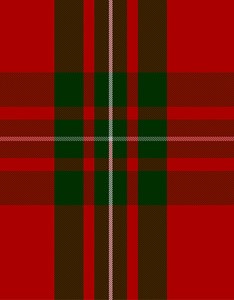

MacGregor Clan
MacGregor Clan Crest can be purchased from Rowan Shields & Plaques
Macgregor( Gaelic -Macgrioghair )
Motto: 'S rioghal mo dhream Royal is my Race
Crest: A Lion's head erased, crowned with an antique crown, Proper
Badge: Scots Pine
War Cry: Ard-Choille
Clan Website: www.clangregor.org
'S rioghal mo dhream (Royal is my race) is the claim of this, one of the most famous of clans, and the principal branch of Clan Alpin. The clan claim descent from Griogar, Son of Alpin, in the 8th Century. The home of the clan was the Eastern border of Argyll and the Western border of Perthshire, including Glenmorchy, Glenstrae, Glenlyon and Glengyle. The earliest possession of the clan, Glenorchy previously owned by the Campbells., was bestowed on the Macgregors for services rendered to Alexander II in his conquest of Argyll.
For a long time the Macgregors maintained possession or their lands by Right of the Sword, but the animosity of surrounding Clans resulted in attempts to displace the clan and the inevitable retaliation by the Macgregors, who thus earned the reputation of being a turbulant clan.
In 1603, Clan Gregor won a victory over the Colquhouns at Glenfruin. The Colquhouns held a Royal Commission and the victory was considered an act of rebellion. The clan was consequently outlawed. Those that were not hunted down and exterminated were forced to change their name. The persecution continued into the reign of Charles I. It was not until 1775 that the clan was restored finally to their rightful name.
One of the most notorious of the name was Rob Roy Macgregor (1671 - 1734) The celebrated Freebooter and Hero of Sir Walter Scott's novel was a son of Lieut-Col. Donald Macgregor of Glengyle.
At the island cemetery on Inchcailloch many of the old chieftains of the MacGregor Clan (Children of the Mist ) are buried.
The actual burying of chieftains at Inchcailloch was a light hearted affair. A good dram was taken before setting out on the boats to convey deceased and mourners to the island cemetery, and another was taken if the weather turned bad and still another on achieving landfall safely. The Ancient Burial Ground of the Macgregors is on Inchcailloch. Many a tale is told of bodies lost overboard or bodies left unburied whilst the company grew merry together.
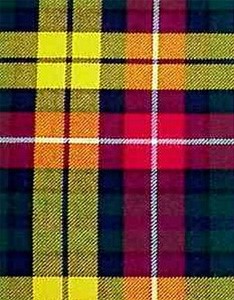
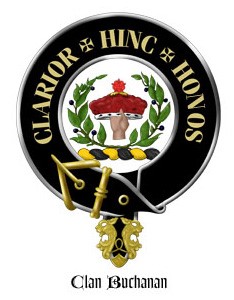
Buchanan Clan
Buchanan Clan Crest can be purchased from Rowan Shields & Plaques
Buchanan: Derives from 'Canon's Seat'
Motto: Hence the brighter honour (Clarior Hinc Honos)
Crest: A dexter hand holding up a ducal cap (Proper), tufted on the top with a rose Gules, with two laurel branches in orle (also proper)
War Cry: Clar Innis
Clan Website: www.traditionalways.com/buchanan.html
The Clan Buchanan held territory in Stirlingshire Scotland on the East side of Loch Lomond and held considerable possessions in the Lennox, and the parishes of Killearn and Strathye.
The name Buchanan comes from the gaelic BOGHCHANAN 'low land belonging to the canon' and BOTHAHANIAN 'the canon's seat. The name obviously points to some connection in early times with the Canon of Inchcailleach.
Around 1016 the first chief of the Buchanan Clan -Anselan O'Kyan was a scion of an Irish Royal Family. The clan fought against the Vikings to reclaim much of the east of the loch. The Buchanans also fought for Robert the Bruce in the early 14th Century.
The Clan bore their full share of the military operations of their country. They supported Bruce in his struggle for Scottish Independence and the Clan was represented in the seven thousand men sent from Scotland to assist the French King after the Battle of Agincourt. It is claimed that Sir Alexander Buchanan killed the Duke of Clarence at the Battle of Bauge in 1421. The Chief of the Clan and Buchanan of Leny fell at Flodden in 1513. The Clan took an active part in the battles of Pinkie and Langside.
The Buchanan lands were sold in 1682 an the principle line became extinct in 1762. Following the death of the 22nd Chief the Chiefship past to Buchanan of Spittal.
George Buchanan, the famous latin scholar, distinguished poet and Protestant reformer was born in Killearn 1506. Educated at St. Andrews and Paris he was imprisoned at the instance of Cardinal Beaton, but escaped to France. He was tutor to Mary, Queen of Scots and was afterwards moderator of the General Assembley and Tutor to James VI. From 1570 till 1578 he was keeper of the Privy Seal. He died 1582.
James Buchanan was the 15th President of the United States of America. There has not been a recognized chief since the late 17th Century.


Colquhoun Clan
Colquhouns Clan Crest can be purchased from Rowan Shields & Plaques
Colquhoun sometimes pronounced Co'hoon
Motto: If I can (Si Je Puis)
Crest: A stags head, couped, gules, attired, argent.
Badge: Hazel Saplings War Cry: Cnoc Ealachain
Pipe Music: The Colquhoun's March Plant
Clan Website: www.clancolquhounsociety.co.uk
A Chief of the Colquhouns was issued a command by the King to seize the well-fortified Dumbarton Castle. He wrote the King back in French, the accepted universal language of the time, "Si Je Puis" (If I Can). The Chief gathered a group of men close to him and hid them in the woods outside of Dumbarton's gates. Then he lured a red stag (deer) by the gates chased by two greyhounds. The starving garrison in the castle opened the gates to chase the stag, whereupon the chiefs clansmen rushed the castle and captured it for the King. One of the most unusual details passed down with this story is that the Chief captured the castle without killing anyone which is remarkable not only for that time but for now, as well. The tour book that used to be passed out at Rossdhu states that the Chief could have been John Colquhoun 10th of Luss and the King, James I, who did choose Sir John to wrest the castle from the "too powerful" Lennox family in 1424.
Other sources say it could be Sir Robert 2nd de Colquhoun (1220-1280 AD) who apparently was the first to take the Colquhoun name (his father was the first Chief, Umfridus de Kilpatrick de Colquhoun).
Whatever the source of their name the Colquhouns have had a long, interesting and sometimes violent history. This Clan may well derive from a Norman immigrant family, or even earlier from a succession of Celtic Priests who were the custodians of the Crozier of St Kessog and who had lived on Monks Island on the loch. The name Colquhoun comes from the territory of that name situated to west of Loch Lomond.
1214 - 1249 Scots King Alexander II During this reign the head of the family - Humphrey De Colquhoun was granted the lands on the west of the loch by Malcom Earl of Lennox. This was confirmed by King Robert the Bruce for the Clan's support in the War of Independence
1368 Sir Robert Colquhoun married the fair Maid of Luss, heiress to nearby lands in Glen Luss and since then the clan name has properly been - Colquhoun of Luss
The Colquhouns supported King Robert the Bruce and backed the early Stewart Kings. In 1602 the Macgregors raided the Colquhouns in Glen Luss killing 2 clansmen, injuring others and carrying off hundreds of livestock.
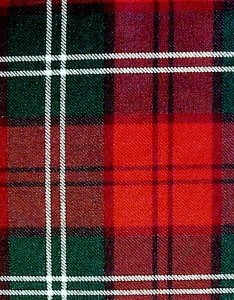
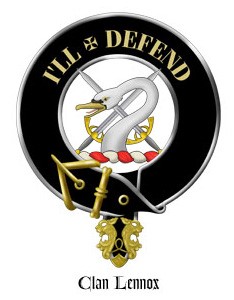
Lennox Clan
Lennox Clan Crest can be purchased from Rowan Shields & Plaques
Gaelic in origin: 'levenach'- smooth stream. From the ancient Celtic Mormaers of Levenach sprang the Earls of Lennox.
Motto: I'll defend I'll defend
Crest: Two Broadswords in saltire behind a swan's head and neck all Proper
Badge: A Rose slipped Gules Clan Website: www.scotclans.com/scottish_clans/clan_lennox/
The ancient Earldom of Lennox included Stirlingshire: Perthshire: Large parts of Renfrewshire: and the whole of Dumbartonshire. The Earls of Lennox became joined to the Royal house of Stewart.
Ruled by one of the Celtic princes known as Mormaers the district of old Levanax (what is mainly Dumbartonshire to-day) was an important part of Scotland. From it arose the powerful Earldom of Lennox which became part of the Royal House of Stewart. The ancient principality of the Lennox, embraced much of Loch Lomond in medieval times.
Late 13th Century The Earls of Lennox were among the most powerful nobles in the realm. The 5th Earl, Malcom supported the Bruce claim to the crown of Scotland.
Lennox fell victim to James I's hatred of all those connected to Murdoch, Duke of Albany, following the murder of the king's brother. This resulted in the execution of both Albany and Lennox in 1425. The succession of title disputed, the lands were divided.
John, Lord Darnley assumed the title of Earl of Lennox in 1488 and sat in the first Parliament of James IV. In 1503, Matthew, the second Stewart Earl of Lennox, obtained from James IV the hereditary sheriffdom of Dunbartonshire, which was made an adjunct of the earldom. In 1513, Matthew, along with the Earl of Argyll, commanded the right wing of the Scots army at Flodden, where he was slain. The younger son of the fourth Stewart Earl was Henry, Lord Darnley, the unfortunate husband of Mary, Queen of Scots. Darnley, who became King Henry upon his marriage, was later murdered, an act which was one of the factors leading to his widow being deposed, and set in motion the What's On which led to her execution at Fotheringay Castle.
In the 19th Century, the Lennox's of Woodhead, later of Lennox Castle near Strathblane, claimed the right to succeed to the Title and Honours of the ancient Earls of Lennox, and although their claim to the peer-age was never established, they were recognised as Chief of the name.
The present Duke of Richmond, Gordon and Lennox, proprietor of the famous Goodwood Race Course, is Charles lennox¹s direct descendent. In the nineteenth century the Lennoxes of Woodhead, later of Lennox Castle near Glasgow, claimed the right to succeed to the title and honours of the ancient Earls of Lennox, and although their claim to the peerage was never established, they were recognised as chief family of the name. The family sold Lennox Castle in 1927, and their chief seat became Downton Castle near Ludlow. The present chief is in the almost unique position of having his grandmother, Madam Kincaid of Kincaid, as a fellow member of the Council of Chiefs.
Remains of the Lennox Stronghold can be still seen on Inchmurrin Island.
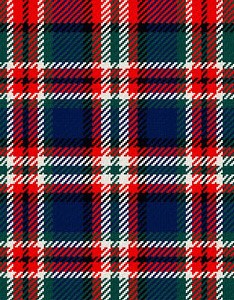
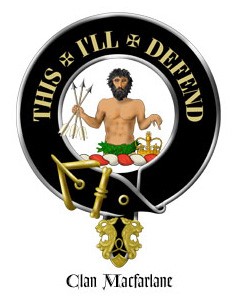
Macfarlane Clan
MacFarlane Clan Crest can be purchased from Rowan Shields & Plaques
Motto: This i'll defend The clans crest and motto alludes to the defence of the crown of the infant James VI
Crest: A demi-savage brandishing in his dexter hand a broad sword Proper and pointing with his sinister to an Imperial Crown or standing by him on the Wreath
Badge: Cranberry, Cloudberry
War Cry: Loch Sloy
Clan Website: www.clanmacfarlane.org/
The MacFarlanes are descendants of the Earl of Lennox whose brother was to bestow the lands at Arrochar, by Loch Long, confirmed to Iain MacPharlain in 1420.
When Earl Duncan of Lennox was executed by James I the MacFarlanes had a valid claim to the title, yet it was given to the Stewarts by the crown. Initially there was some dispute but they would remain loyal to the Stewarts.
The Macfarlanes are decended from Alwyn, Celtic Earl of Lennox. whose younger son, Gilchrist received lands at Arrochar on the shores of Loch Long at the end of the 12th century.
Robert the Bruce when forced to flee the lochside and reach safety of the west Highlands was shelterd by Malduin, grandson of Gilchrist.
Duncan, the last Celtic Earl of Lennox, was executed by James I and although the Macfarlanes had a valid claim to the Earldom, the title was given to John Stewart, Lord Darnley.
When the Stewarts proved too powerful for the Macfarlanes opposition Andrew Macfarlane, the 10th Chief, married a younger daughter of Lord Darnley, cementing a new alliance.
Clansmen fell at Flodden in 1513 along with the 11th chief and at the Battle of Pinkie in 1547 along with Duncan the 13th chief while opposing the invading English.
After the the murder of Lord Darnley (Mary Queen of Scots' second husband) the Macfarlanes opposed the Queen and were noted for their gallantry at the Battle of Langside in 1568.
They fought at Montrose's great victory at Inverlochy in 1645. The clan does not seem to have played any major part in the Jacobite risings of 1715 and 1745.
The 20th chief, Walter Macfarlane who lived in Edinburgh for most of his life died in 1767 and the clan lands at Arrochar were sold off. The direct male line of the chiefs failed in 1886. Walter, the 20th Chief, (mid-18th Cent.)
Walter was a renowned scholar and antiquarian. At the site of his home now stands the Landmark Cobbler Hotel which contains an inscribed stone taken from the original house over the main doorway.
Loch Lomond .net